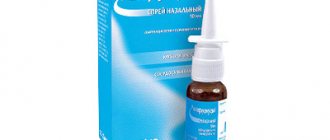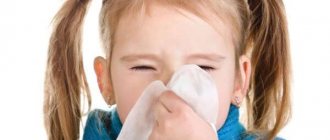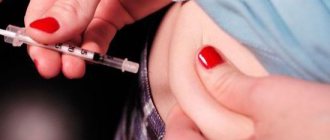Classification of ointments for the common cold
Any ointment for a runny nose for children or adults, by type and nature of action, can be one of the types listed in the list:
- antiviral ointment - the product is often used for prophylactic purposes during times of exacerbation and active spread of infections and viruses;
- ointment based on antiseptics - often has therapeutic purposes and is used to suppress the activity of bacteria;
- combined formulations are designed to provide a general healing effect and are used as an independent complex. Often in practice they turn out to be the most effective compared to other ointments;
- Homeopathic ointments differ from analogues in their completely natural composition. Such agents can be used as part of an antiviral or antibacterial complex.
What ointments are used for a runny nose?
How to use ointment for a runny nose? Typically, antiviral balms are prescribed during periods of exacerbation of various acute and respiratory diseases, when everyone should be more attentive to their own health. The use of the product involves applying the drug to the nasal mucosa in order to create a barrier to the penetration of viruses into the human body.
Antiviral drugs include the following:
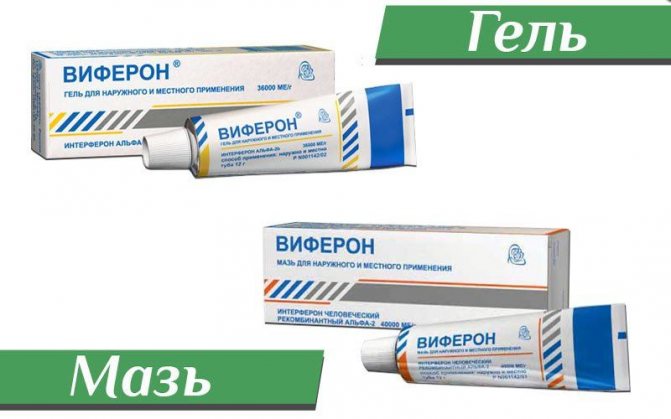
Viferon, created on the basis of the drug interferon, is prescribed when a child or adult has just fallen ill. This cream removes virus particles from cells, relieving the patient of rhinitis. For preventive purposes, the balm is applied to the nose; it should be used throughout the fall and winter. As a treatment, the course lasts about 2 weeks. In practice, the ointment has no side effects, only the development of allergies that occurs as a result of long-term treatment is possible.- Oxolinic ointment is one of the most popular means of fighting influenza or herpes, runny nose, and damage to the nasal epithelium. The drug is sold in pharmacies in the form of a 0.25% ointment. The product is applied in a thin layer to the nasal mucosa. This procedure needs to be done 3 times a day for about 30-40 days while the epidemic period lasts. It should not be used if the virus has penetrated deeply into the body and the disease has already entered the active phase. Sometimes during use there is a burning sensation, but it quickly passes. If the irritation does not go away, you should stop applying the product to the nasal mucosa to prevent allergies from developing.
Ointments for the common cold for children: which ones and why they can and cannot be used
When faced with a child's runny nose, a parent strives to quickly cope with the symptoms. Despite the widespread belief in the benefits of treating a child’s runny nose with ointments (which, according to medical statistics, is true), few parents remember about the child’s comfort. It is worth discussing the upcoming treatment and, if necessary, using game practices. It is also worth taking into account the fact that each individual product has contraindications.
For example, if the child is under 2 full years of age, it is better to use:
- the well-known cast of “Zvezdochka”. A remedy from the times of the Soviet Union that has not lost its popularity;
- Evamenol;
- Fleming's ointment;
- Tuyu.
Important! All of these remedies are best used after a preliminary visit to the children's clinic and consultation with a doctor. He will make an accurate diagnosis and select medications for the parent and child. Self-medication without following the instructions for use of the drug, without a doctor’s prescription, can lead to serious consequences.
The use of ointments based on Vaseline and aggressive herbs for the treatment of runny nose in children under 2 years of age is not recommended. This may result in partial or complete dysfunction of the child's nasal passages.
complex drops for children
Well, we arrived after the next ultrasound and our happiness knows no bounds, the consultation that was scheduled for 30 weeks was canceled, since there was no point in it, our baby is developing well according to the deadline, one ventricle is still dilated, but the dynamics are stable and there is no increase in reduction! The uzistka said the baby is good, healthy, but there is one thing, but she still cannot understand why this expansion is happening, the diagnosis that we were given, namely Arnold-Chiari, cannot be confirmed, since at this stage the child should already have developed hydrocephalus and back bifida, but we don’t have this, they diagnosed stage 1 FGR, which means we are 1.5-2 weeks behind in development, but again, after looking at all this, they removed all the ultrasounds for us because they made a mistake in the calculation of weeks and gave us more than 1 week and three days! They said now we don’t have to go to an ultrasound scan every two weeks, since the dynamics are stable and there is no point in constantly watching the baby! Now we are expected to have an ultrasound at the end of June, and they will specifically tell us the outcome of the conclusion! Now I don’t even have the slightest doubt that the baby is completely healthy! My husband and I are now waiting for an ultrasound in June, maybe it will still seem to us who will be a son or a daughter, and if not, then we will be waiting for a surprise at the birth! You can breathe easy for now and continue to enjoy your pregnancy! How good it is when you have strong support from your husband, parents and work colleagues, who throughout this time said that this is not true and that the baby will be healthy! As I begin to remember that I had to go from 20 to 28 weeks, I still shudder from all this horror and tears appear in my eyes! You just need to always believe in yourself and in your baby, no matter how bad things get, you can always find a way out of the situation, and get checked by at least three different doctors and preferably in different cities if possible, because you can terminate a pregnancy at any term, and it’s more difficult to save your baby from a medical error, doctors know how to put a lot of pressure on pregnant women, and since our psyche is already unstable, not many people conclude that doctors understand more and make an interruption! After talking with her local doctor, she told me how good it is that you prolonged the pregnancy and show from your experience that you shouldn’t give up if the conclusion was made by one doctor, and how many healthy children have already been ruined by our doctors and it’s just terrible, but there are cases where it really everything is confirmed and it’s worth making an interruption, but believe me, they are rare!
Contraindications for the use of local remedies for the treatment of runny nose

Having decided to apply ointment to the nose for a runny nose, it is important to carefully study the instructions for use, read the list of contraindications for each individual product and only then use it. And strictly with extreme caution. For example, compositions based on antiseptics can only be used:
- for the treatment of children over 6 years of age;
- in the absence of pregnancy and breastfeeding;
- in the absence of diseases of the internal organs, especially the kidneys and liver;
- in the presence of an active stage of allergy or individual intolerance.
In general, any ointment intended for the treatment of a runny nose is prohibited for use if rhinitis is accompanied by yellow or purulent discharge. Such a symptom may indicate the presence of a number of problems: from the development of complications or a severe stage of the disease to the activation of the inflammatory process. In case of inflammation, strictly comprehensive treatment prescribed by an experienced doctor is recommended.
Common and effective antiviral ointments
The peculiarity of antiviral compounds lies in the effectiveness of their use for preventive purposes, especially during periods of epidemics and mass outbreaks of ARVI. The effectiveness of treatment is observed if the drug is used when the primary symptoms of the disease are detected. Antiviral ointments for the common cold are designed to destroy and remove viral microscopic organisms from affected tissues.
Among the most common names in this group are:
- Tetracycline. Has excellent antimicrobial effect. Promptly suppresses the activity of pathogenic viruses. According to patient reviews, Tetracycline ointment is very effective. It is better to use the product no more than 2-3 times during the day and provided that the runny nose is not fungal or allergic in nature. The ointment is contraindicated for pregnant women, as well as during lactation and children under 6;
- Viferon. It is used primarily to suppress the symptoms of an already established disease and is especially effective in detecting the primary signs of a runny nose. The main advantage is the possibility of use for the treatment of children and adults;
- Oxolinic ointment for a runny nose. This is almost the most common composition used as a prophylactic agent. The advantage is a small number of contraindications, but use for the treatment of children is not recommended. Another advantage is availability and low cost. The use of Oxolinic ointment for a runny nose may cause a feeling of discomfort in the nose, which indicates an allergy or intolerance. Despite this, Oxolinic ointment is often used by patients;
- Zinc ointment is often prescribed for allergies that are a consequence or cause of a runny nose. Due to its antiviral nature, the zinc composition successfully suppresses the activity of viral microbes and promotes a speedy recovery.
Ointment for runny nose, snot and nasal congestion: list of the best remedies
The cause of a runny nose may be the irritating effect on the nasal mucosa of allergens, pathogenic viruses and bacteria. Therefore, ointment for the common cold for children and adults is selected taking into account the etiological nature of rhinitis. Many of them belong to the antiviral and antiseptic group. There are also combined and homeopathic external remedies.
Ointments against viruses and bacteria
During a cold, mucus is produced due to swelling of the nasal cavity caused by the action of viruses.
You can prevent a runny nose using ointments:
- Viferon is based on human interferon, which plays a major role in the prevention of colds and flu by suppressing the replication of RNA and DNA viruses. The drug also contains antioxidants that enhance the antiviral activity of interferon. The ointment for the common cold is safe for both adults and children from one year of age. A thin layer of the product is applied to the mucous membrane of the nasal passages for five to seven days.
- Oxolinic ointment has a pronounced antiviral effect. The viral form of rhinitis is treated with a 0.25 percent form of the drug, lubricating the passages of the nostrils twice to three times a day. A runny nose heals after three to four days. To prevent colds, use ointment twice a day. The effectiveness of Oksolin has been proven by time. It is a therapeutic and preventive remedy for the common cold.
- Tetracycline ointment is considered a potent drug that destroys pathogens. If rhinitis is caused by bacteria, then use the remedy safely. But it cannot cure viral or fungal infections. A thin layer of tetracycline ointment is applied to the site of inflammation. The procedure is carried out twice a day with a course of treatment from several days to three weeks. The product is contraindicated for children under eleven years of age, pregnant women and nursing mothers.
- Miramistin has a powerful antibacterial effect. A large number of microorganisms are sensitive to the components of the drug. The nasal mucosa is treated with ointment up to three times a day. The course of therapy is no more than ten days. Contraindications include children under three years of age. The product may cause a slight burning sensation and swelling, so use it with caution.
- Bactroban can only fight a certain type of bacteria, so the ointment does not always help with rhinitis. Before using the product, consult a specialist who will tell you whether the drug will help cope with a runny nose or not.
- Vishnevsky's liniment is used in rare cases. But if it is necessary to soften the tissues of the nasal mucosa and increase blood flow, then this nasal ointment for a runny nose can improve breathing and cleanse the channels. The balm is applied to the nose with a bandage or cotton swab on top. Warming the tissue will lead to the drainage of serous or purulent exudate. Turundas made of cotton wool, lubricated with Vishnevsky's liniment, are placed inside the nostrils for five minutes. Inflammation of the nasal cavity after the procedure decreases, and the swelling of the epithelium inside the olfactory organ also decreases.
Before starting to use medications, it is necessary to identify the cause of the runny nose and consult with a specialist on methods of treating it.
Combination products
Ointment for a runny nose Pinosol contains eucalyptus and pine oil. It contains menthol and thymol. The drug is used only in the treatment of viral and bacterial rhinitis. Allergic rhinitis cannot be cured. Inject the ointment into the nose using cotton swabs, simultaneously squeezing the wings of the nose. This way the product is distributed throughout the entire mucous membrane of the organ.
Use about half a cubic centimeter of external agent at a time, carrying out the procedure three times a day. The course of treatment with the drug ranges from seven to fourteen days.
The drug Levomekol is prescribed when a runny nose is caused by the penetration of staphylococci and Pseudomonas aeruginosa into the body. Penetrating into tissues, chloramphenicol and methyluracil stimulate the restoration of the mucous membrane. The ointment is filled into the nasal cavity once a day. It is forbidden to use Levomekol for children under one year of age, persons susceptible to allergies, and pregnant women.
A drug with a specific odor of menthol and eucalyptus, Evamenol has an irritating effect, narrowing the blood vessels of the nasal cavity. The components of the product stimulate tissue receptors, reducing inflammation and swelling.
Evamenol is classified as a symptomatic drug for the treatment of acute and chronic rhinitis. For children under two years of age, the use of the product is prohibited. A small amount of ointment is applied to the nasal mucosa two or three times a day.
The course of treatment with the drug is five to seven days.
Homeopathic remedies for runny nose
Among the common ointments for the treatment of runny nose are those prepared using medicinal plants and extracts based on them.
The homeopathic remedy Doctor Mom contains essential oils of eucalyptus, nutmeg, thymol, camphor and levomenthol. The ointment relieves nasal congestion after application to the wings of the nose. The drug is contraindicated for children under two years of age and pregnant women.
Balm Zvezdochka is for external use. When lubricating the nose, you must be careful not to get the ointment on the mucous membranes of the nose and eyes.
The ointment contains clove oil with anti-inflammatory properties, eucalyptus oil with antibacterial properties, and Chinese cinnamon oil, which warms tissue. Camphor laurel oil improves nasal breathing and promotes the outflow of mucus.
The balm is used carefully, after testing the body's reaction to its components in advance.
Apply a small amount of the external product to the active points of the face, located on the wings of the nose, earlobes, between the eyebrows, and on the chin. During the procedure, the point is pressed and massaged, rubbing the ointment in for one to two minutes.
The basis of Fleming's nasal ointment for a runny nose is menthol, carotenoids, and glycosides. The drug is used in the treatment of rhinitis of various etiologies. The drug is safe and effective in treating a runny nose in a child of any age. For rhinitis, lubricate the mucous membranes of the nose or place turundas in the nostrils for five to seven minutes, twice or thrice a day. The course of treatment is no more than a week.
Among the ointments for nasal congestion, Thuja is distinguished, which is used in the complex treatment of rhinitis. Turundas with the drug are placed in the nose for five to ten minutes, and the snot disappears completely after seven days.
How to properly use ointments for a runny nose
Among all the drugs, ointments for the common cold bring minimal effect, but they are necessarily used in the complex treatment of rhinitis. The peculiarity of nasal creams is that they are used for moderate runny nose or for preventive purposes.
Apply the ointment inside the child's nose with the tip of the little finger. Cotton swabs are not used to apply the product: they can remain in the nasal cavity and cause serious consequences in the form of suppuration.
In order for the components of the drug to enter the deep passages of the cavity, it is necessary to draw air into yourself by pinching the nostrils several times.
For adult patients with a runny nose, turundas soaked in the chosen remedy are placed inside the nasal passage. Their residence time in the nose is five to ten minutes. Preparations with an irritating, warming effect are applied to the wings of the nose.
We can talk about the effectiveness of a particular ointment for a runny nose when it gives results in the treatment of rhinitis of a particular patient.
Its effect depends on the condition of the nasal cavity, the cause of rhinitis, and the body’s perception of the components of the product.
If the medicine is selected by a specialist, the treatment will be high-quality and effective.
What ointments will help a child get rid of a runny nose?
The nasal mucosa takes a hit during colds. Diseases often begin with the appearance of watery, copious mucus from the nose.
And only then they are joined by a cough, fever and headache. The nasal cavity protects the throat, trachea, and bronchi from bacteria entering them.
Active substances on the mucosal epithelium reduce the activity of viruses and neutralize toxins.
Mucus dries quickly during a cold, especially when the air in the room becomes dry and its temperature rises above 21 degrees Celsius. Vasoconstrictor nasal drops will not keep your nose moist. It will be increasingly difficult for the child to breathe, and the infection with the air will go further, causing inflammation of the bronchi.
Natural remedies for the common cold are suitable for treating children. Lubricating the nose:
- balm Zvezdochka;
- Pinosol;
- Fleming's ointment;
- Doctor Mom ointment;
- Evamenol.
You can eliminate the flow of mucus and reduce inflammation. These ointments are suitable for young children from two years of age, they are safe and will help cope with rhinitis in five to seven days.
Before putting the product into the spout, it is necessary to rinse the cavity with sea salt-based sprays or saline solution with sodium chloride. Then put a dose of ointment into each nostril, squeezing the wings of the nose with your fingers.
The child must be in a supine position during the procedure. If the product causes a burning sensation or irritation of the mucous membrane of the nose, then stop using it.
You cannot treat a runny nose on your own, since only a pediatrician can determine the nature of its occurrence.
Yulia Kalashnik
Source: https://VipLor.ru/nos/rinit/maz-ot-nasmorka
Combined action ointments
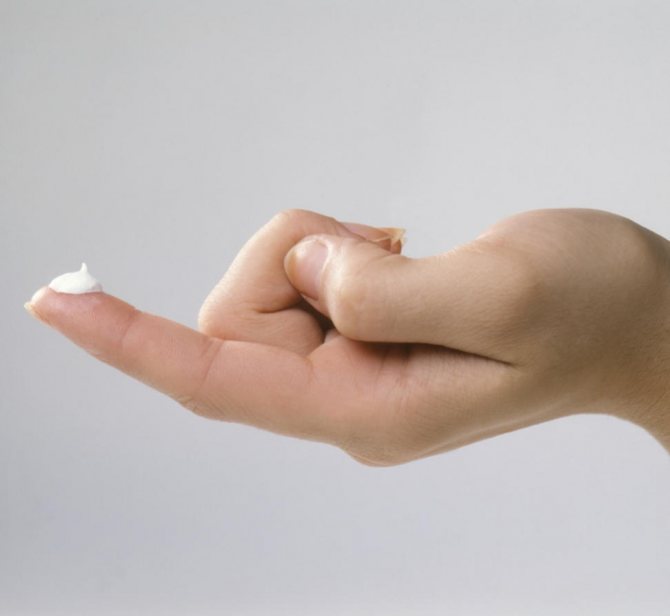
Products for use by application to the nasal mucosa belonging to this group help to easily cope with the main symptoms of a runny nose: congestion and swelling. This is due to the targeted activity of the components included in the composition.
Among the most effective ointments of combined action are:
- Levomekol. Most often, the appointment occurs when the attending physician discovers a bacterial infection during an examination. Levomekol is used by dipping cotton swabs into it and then inserting them into the nasal passages. You will need to keep them for at least 3-4 hours, depending on the doctor’s recommendations;
- Pinosol. This ointment has gained popularity due to its 100% naturalness. The main components of Pinosol: pine, mint and eucalyptus oil. The drug is often prescribed to suppress the acute stage of vasomotor rhinitis and relieve dry mucous membranes;
- Ointment for runny nose Evamenol. A product that has anti-inflammatory and antiseptic effects. The duration of use, depending on the indications, is no more than 10 days. The frequency of use should not exceed 2-3 times per day. Doctors note that it is impossible to use Evamenol to treat children's runny nose if the child is under 2 years old. The composition is not contraindicated for pregnant women.
Complex nasal drops for children: recipe
If a child has a persistent runny nose, the doctor may prescribe the use of complex drops.
They are also considered an effective component in the complex treatment of a child for sinusitis.
It must be remembered that the components are adjusted and selected by a specialist for a child of a certain age. Most often, complex nasal drops with Miramistin are recommended for children.
Many parents ask the question: “How to prepare complex drops for infants?” The composition of such a mixture may include: hydrocortisone, naphthyzine and children's dioxidine 0.5%. All ingredients should be mixed well, maintaining the proportions.
Attention
For infants, the use of dioxidine can be dangerous and is justified only in extreme cases when other means have not had the desired effect in treatment, or there is a severe degree of infection.
Before use, it is necessary to clean the child's nasal passages. First you need to rinse with sea water or Aquamaris solution. If a child has snot, they should be removed using special suction devices (a bulb or a nozzle suction device). After this, it is advisable to clean your nose with cotton wool.
Next, you need to apply the drops according to the scheme: two drops in each nostril. Sometimes a burning sensation may appear in the nasal cavity, so 5 minutes after instillation you should add one drop of peach oil.
If it is difficult for a child to drip the product into the nasal cavity, then you need to moisten cotton swabs in this solution and insert them into each nasal passage. Keep for about 5-10 minutes.
Most parents, if their child has congestion and know about the effectiveness of these drops, ask the question: “How to prepare the solution at home?” Below are a few simple recipes:
- The drops contain: 0.5 ml of 1% Dexamethasone and 2 ml of 30% Lincomycin, 2.5 ml of 1% Dioxidin and 1 ml of Nasonex. The resulting mixture should be shaken well;
- To prepare it you will need Nazivin, 10% Lincomycin and Nasonex. Mix in equal proportions and add one ml of aloe juice to them.
- It is necessary to mix 10% Lincomycin with one ampoule of 10 ml of 1% Diphenhydramine (can be replaced with Suprastin). The resulting composition should be mixed well and a bottle of Vibrocil should be added to it. That is, in a ratio of 0.1:1:1.
Many parents note that drops with aminocaproic acid help effectively fight children's runny nose. This medication allows you to quickly get rid of the symptoms of rhinitis and nasopharyngitis.
For infants, drops with streptomycin can be used, which has a good antibacterial effect on the mucous membrane.
For adenoids, the child is prescribed drops with ceftriaxone. It must be mixed in equal proportions with Dexamethasone and Naphthyzine.
Antiseptic compounds
As for the antiseptic group of topical drugs, it is worth highlighting:
- Fleming's ointment already discussed;
- Pinosol;
- Tuyu;
- "Star"
Despite the fact that the products belong to other treatment groups, they each have an antiseptic effect in their own way.
Important! It is highly not recommended to use the products discussed without consulting a doctor and following the instructions for use. This can lead to the development of inflammation, exacerbations and other adverse events.
